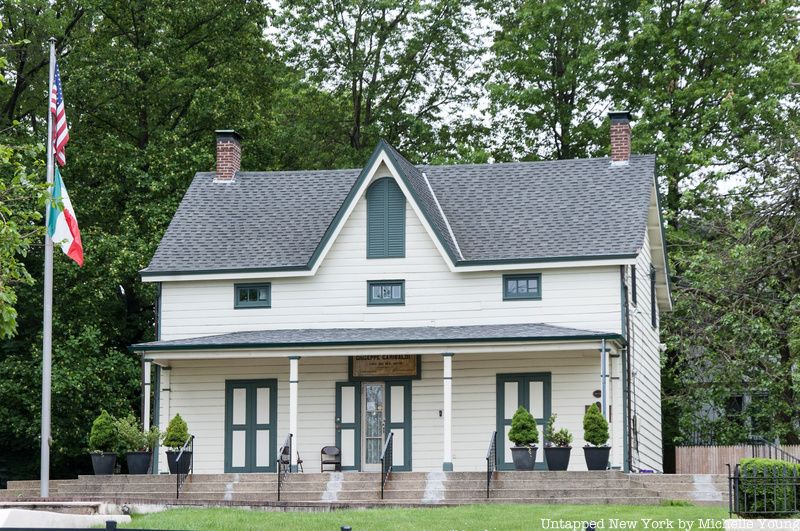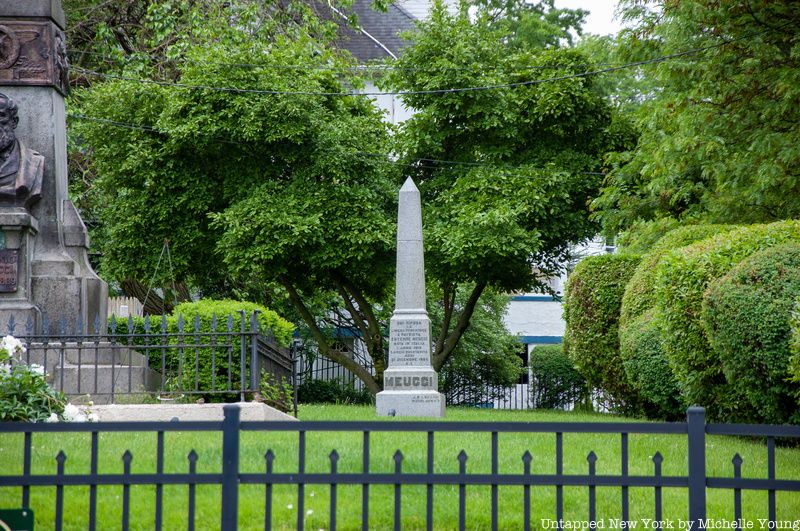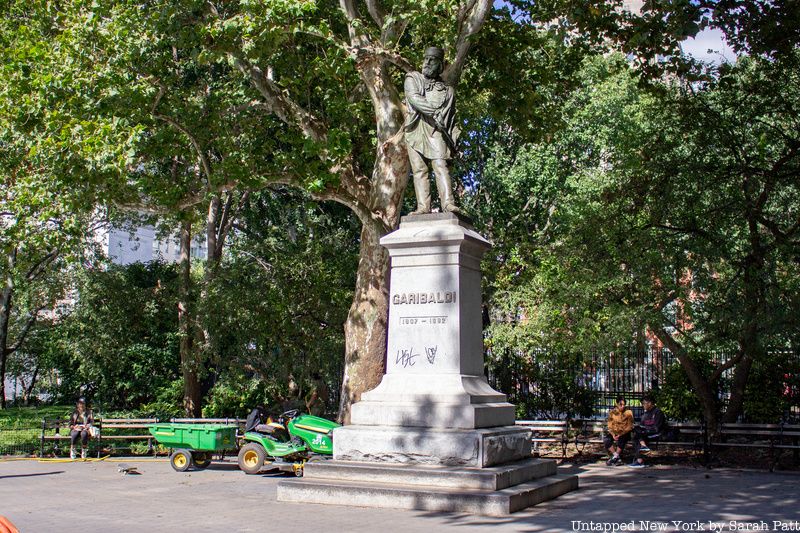Last-Minute NYC Holiday Gift Guide 🎁
We’ve created a holiday gift guide with presents for the intrepid New Yorker that should arrive just in time—


The Italian nationalist Giuseppe Garibaldi (1807–1882) was memorialized with a bronze statue in Washington Square Park in New York City in 1888. With statues a subject of recent controversy, especially as Columbus Day approaches yet again, the historical context behind this surprising statue of Garibaldi is worth digging into. The mid-nineteenth century was the age of the nationalist revolutionary as an international celebrity, of which Garibaldi was one of the main exemplars, having spent time in exile in Uruguay and New York.

Garibaldi lived in New York from the summer of 1850 to the spring of 1853, arriving to the United States through the Staten Island Quarantine Station just a few years before it was burned down by a mob of arsonists. Garibaldi arrived “lonely and impoverished,” describes the New York City Landmarks Preservation Commission. He first stayed at the Pavilion Hotel in St. George, Staten Island. But for the majority of his time in New York, Garibaldi stayed in Rosebank, Staten Island with the Florentine inventor, Antonio Meucci. Meucci goes down in history for inventing the telephone, sixteen years before Alexander Graham Bell. He filed a caveat, a kind of pre-patent announcement, for his telephone design in 1871 but was unable to renew it due to financial difficulty, opening the door to other inventors. Garibaldi and Meucci met while working at a candle factory on Staten Island.
 The Garibaldi-Meucci Museum on Staten Island
The Garibaldi-Meucci Museum on Staten Island
The musician Max Maretzek offered his house in Rosebank to Garibaldi and Meucci while he was going to be in Havana, Cuba. This two-story wooden clapboard house in the Gothic Revival style is now known as the Garibaldi-Meucci Museum. It was inaugurated in 1956 after the Order Sons of Italy in America rescued it from disrepair and abandonment, and was designated a New York City landmark in 1967.
Today, due to the resurgence of reactionary nationalism around the world, it is hard to imagine political figures that transcend their national appeal to achieve international cult status. However, in the eighteenth and nineteenth centuries it was not uncommon for revolutionary figures to have transnational careers and fame. For example, Europeans such as Marquis de Lafayette and Tadeusz Kosciuszko participated in the American Revolution. Today any New Yorker knows their names, which are part of the geography of the city. But unlike these earlier international heroes, the revolutionary nationalists of the nineteenth-century benefitted from the advent of mass communications. Developments such as increased literacy rates, the invention of photography, and the proliferation of print culture made them into celebrities.
The nationalist social movement that emerged in post-Napoleonic Italy, known as Risorgimento, helped elevate Garibaldi into a cult figure. Giuseppe Mazzini as a former journalist knew the power of the Romantic myth of the lone hero and Christian martyrdom. Mazzini knew that it was through the politicization of cultural tropes that the idea of the nation could emerge. For Mazzini, Garibaldi was like a literary hero whose adventures, defeats, and exiles could capture the public’s imagination. In other words, nationalists forged mass support for the nation through popular narrations of martyrdom and heroism.

A monument to Meucci in front of the Garibaldi-Meucci house
It was in fact a defeat that brought Garibaldi to New York via Tangier and Liverpool. Garibaldi’s exile in New York could have not been more different than his years in Uruguay. While in Uruguay, from 1833 to 1848, Garibaldi engaged in military action. This experience in battle cemented his legend as a defender of a small republic against the despotism of neighboring Argentina. In contrast, Garibaldi’s time in New York was remarkably quiet, almost as if he needed time to reflect after the defeat of the Roman Republic by Louis-Napoleon in 1849 on behalf of Pope Pius IX. He had also lost his wife. Garibaldi’s arrival in New York in 1850 did not generate the same fanfare given to other nationalist leaders, such as the Hungarian nationalist Lajos Kossuth, who had a military parade on Broadway.
Garibaldi’s avoidance of the public in New York was in part due to bad health. At that time of his arrival, Garibaldi was suffering from rheumatism. But other likely reasons for his lack of public engagement were the culture wars of the time. In Italy, Garibaldi had fought against the Papal States which were an obstacle for the unification of the Italian peninsula. This made Garibaldi an unwelcome figure for the archbishop of New York, John Hughes, and other Catholics. Furthermore, Garibaldi’s republicanism was also appealing to “red republicans” or socialists, a group at odds with American republicanism.

A memorial to Meucci’s wife Esterre stands behind the one to Meucci
Garibaldi lived in the house on Staten Island for eighteen months, but decided to return to Italy in 1853 to resume his nationalist efforts. According to the Landmarks Preservation Commission’s designation report for the house, “The task of leading his “One Thousand” to Sicily in 1860 to defeat the armies of the Bourbon Kings, the liberation of the south of Italy, and the unification of Italy still lay before him at this time. Garibaldi died in 1882, having realized all his goals.”

Garibaldi’s statue in Washington Square Park is only one of many monuments to Italian historical figures in New York City. Mazzini himself has a bust in Central Park, sculpted in 1878, Columbus Circle was built for the 400th anniversary of the explorer’s arrival to the Americas in 1892 (one of the many Christopher Columbus statues in New York City), and the opera composer Giuseppe Verdi had a statue dedicated in 1906 on the Upper West Side. The sculptor of the statues of Mazzini and Garibaldi was Giovanni Turini, who fought alongside Garibaldi in the Italian war against Austria in 1866.

The statue of Columbus at Columbus Circle during the art installation, Discoering Columbus, by Tatzu Nishi
The statues of Italian national heroes in New York were gifts from Italians to the city. In the late nineteenth century, Italian-American associations and newspapers such as Unione e Fratellanza, L’Eco D’Italia, and Il Progresso Italo-Americano raised the funds for the statues of Mazzini, Garibaldi, Verdi, and Columbus (who has become the most controversial of them all). It was in particular the initiative of Italian businessman Carlo Barsotti who made possible the sculpting of these statues. For Barsotti — himself an example of immigrant social mobility — monuments were a form of civic engagement for immigrant communities. It was a way for Italians to claim belonging to the city outside their marginalized ethnic enclaves or Little Italies.
Debates over the past and its commemoration expose the intellectual tension between universalism and particularism. Should historical figures be judged based on what society accepts as universal values or on the social and cultural contexts of their time? The nationalism of the nineteenth century certainly represents different values than the nationalism of the twentieth and twenty-first centuries. In this age of historical revisionism, where does Garibaldi fit?
Next, discover the other secrets of Washington Square Park.
Subscribe to our newsletter